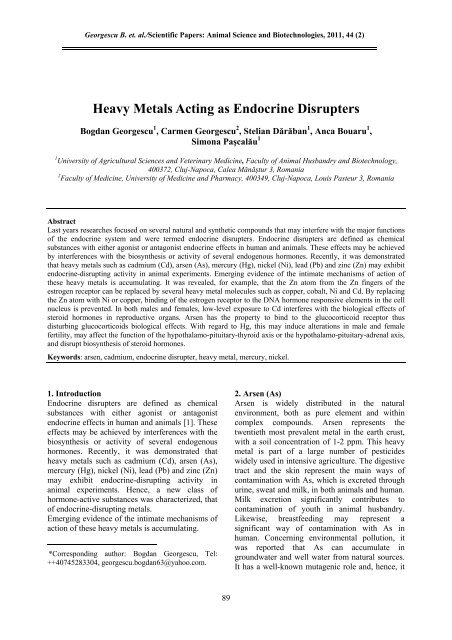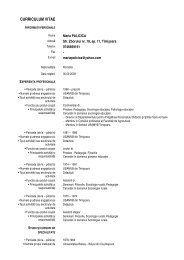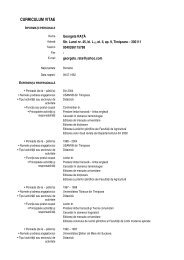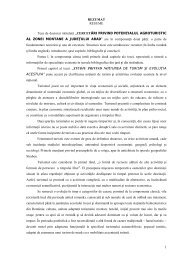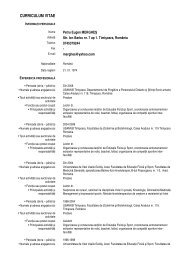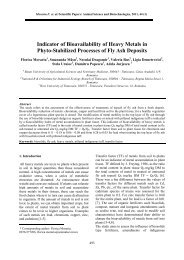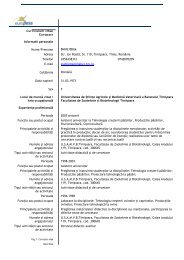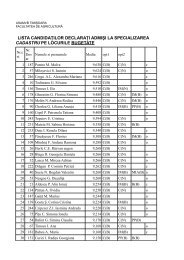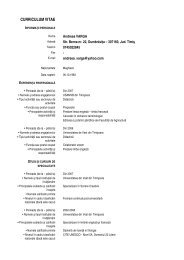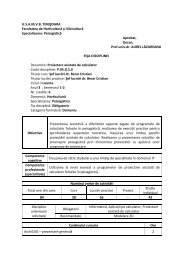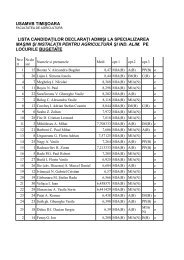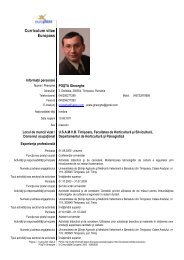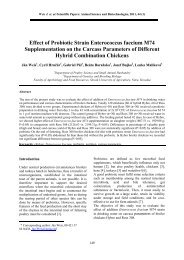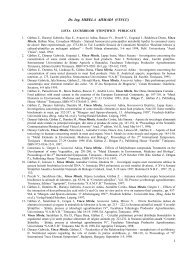Heavy Metals Acting as Endocrine Disrupters
Heavy Metals Acting as Endocrine Disrupters
Heavy Metals Acting as Endocrine Disrupters
You also want an ePaper? Increase the reach of your titles
YUMPU automatically turns print PDFs into web optimized ePapers that Google loves.
Georgescu B. et. al./Scientific Papers: Animal Science and Biotechnologies, 2011, 44 (2)<strong>Heavy</strong> <strong>Metals</strong> <strong>Acting</strong> <strong>as</strong> <strong>Endocrine</strong> <strong>Disrupters</strong>Bogdan Georgescu 1 , Carmen Georgescu 2 , Stelian Dărăban 1 , Anca Bouaru 1 ,Simona Paşcalău 11 University of Agricultural Sciences and Veterinary Medicine, Faculty of Animal Husbandry and Biotechnology,400372, Cluj-Napoca, Calea Mănăştur 3, Romania2 Faculty of Medicine, University of Medicine and Pharmacy, 400349, Cluj-Napoca, Louis P<strong>as</strong>teur 3, RomaniaAbstractL<strong>as</strong>t years researches focused on several natural and synthetic compounds that may interfere with the major functionsof the endocrine system and were termed endocrine disrupters. <strong>Endocrine</strong> disrupters are defined <strong>as</strong> chemicalsubstances with either agonist or antagonist endocrine effects in human and animals. These effects may be achievedby interferences with the biosynthesis or activity of several endogenous hormones. Recently, it w<strong>as</strong> demonstratedthat heavy metals such <strong>as</strong> cadmium (Cd), arsen (As), mercury (Hg), nickel (Ni), lead (Pb) and zinc (Zn) may exhibitendocrine-disrupting activity in animal experiments. Emerging evidence of the intimate mechanisms of action ofthese heavy metals is accumulating. It w<strong>as</strong> revealed, for example, that the Zn atom from the Zn fingers of theestrogen receptor can be replaced by several heavy metal molecules such <strong>as</strong> copper, cobalt, Ni and Cd. By replacingthe Zn atom with Ni or copper, binding of the estrogen receptor to the DNA hormone responsive elements in the cellnucleus is prevented. In both males and females, low-level exposure to Cd interferes with the biological effects ofsteroid hormones in reproductive organs. Arsen h<strong>as</strong> the property to bind to the glucocorticoid receptor thusdisturbing glucocorticoids biological effects. With regard to Hg, this may induce alterations in male and femalefertility, may affect the function of the hypothalamo-pituitary-thyroid axis or the hypothalamo-pituitary-adrenal axis,and disrupt biosynthesis of steroid hormones.Keywords: arsen, cadmium, endocrine disrupter, heavy metal, mercury, nickel.1. Introduction<strong>Endocrine</strong> disrupters are defined <strong>as</strong> chemicalsubstances with either agonist or antagonistendocrine effects in human and animals [1]. Theseeffects may be achieved by interferences with thebiosynthesis or activity of several endogenoushormones. Recently, it w<strong>as</strong> demonstrated thatheavy metals such <strong>as</strong> cadmium (Cd), arsen (As),mercury (Hg), nickel (Ni), lead (Pb) and zinc (Zn)may exhibit endocrine-disrupting activity inanimal experiments. Hence, a new cl<strong>as</strong>s ofhormone-active substances w<strong>as</strong> characterized, thatof endocrine-disrupting metals. 1Emerging evidence of the intimate mechanisms ofaction of these heavy metals is accumulating. *Corresponding author: Bogdan Georgescu, Tel:++40745283304, georgescu.bogdan63@yahoo.com.2. Arsen (As)Arsen is widely distributed in the naturalenvironment, both <strong>as</strong> pure element and withincomplex compounds. Arsen represents thetwentieth most prevalent metal in the earth crust,with a soil concentration of 1-2 ppm. This heavymetal is part of a large number of pesticideswidely used in intensive agriculture. The digestivetract and the skin represent the main ways ofcontamination with As, which is excreted throughurine, sweat and milk, in both animals and human.Milk excretion significantly contributes tocontamination of youth in animal husbandry.Likewise, bre<strong>as</strong>tfeeding may represent <strong>as</strong>ignificant way of contamination with As inhuman. Concerning environmental pollution, itw<strong>as</strong> reported that As can accumulate ingroundwater and well water from natural sources.It h<strong>as</strong> a well-known mutagenic role and, hence, it89
Georgescu B. et. al./Scientific Papers: Animal Science and Biotechnologies, 2011, 44 (2)is <strong>as</strong>sociated with incre<strong>as</strong>ed dise<strong>as</strong>e risksincluding bladder, lung, skin and other cancers.Moreover, pilot data suggest diabetogenic,neurological and reproductive effects, likewise.Incre<strong>as</strong>ed health risks may occur at levels <strong>as</strong> low<strong>as</strong> 10-50 ppb, while biological effects have beenobserved in experimental animal and cell culturesystems at much lower levels.Arsen is the first metal to be linked with endocrinedisruption through binding to the glucocorticoidreceptor and interfering with glucocorticoidhormones activity in several biological processes.In fact, instead of activating the glucocorticoidreceptor, <strong>as</strong> for example organochlorine pesticidesdo after binding to the estrogen receptor, As ratherinhibits glucocorticoid receptor-mediated geneactivation. In a similar manner, this metalinterferes with the estrogen receptor. Experimentshave shown that As markedly suppressed estrogenreceptor-dependent gene transcription of the 17ßestradiol-induciblevitellogenin gene in chickenembryo liver [2]. In cell cultures, non-cytotoxicconcentrations of As of 2-225 ppb significantlyinhibited estradiol receptor-regulated effects inhuman bre<strong>as</strong>t cancer MCF-7 cells [2].3. Cadmium (Cd)The main sources of contamination with Cd arerepresented by industrial aerosols, water w<strong>as</strong>tesfrom extraction mines, phosphate-b<strong>as</strong>ed fertilizers,Cd-containing pesticides etc. It h<strong>as</strong> beendocumented that in the industrial area, Cdconcentration in the air peaks to 0.03 mg Cd/ m 3 .Fodder plants are the main constituents throughwhich Cd enters the food chain. It w<strong>as</strong> shown thatCd levels in fodder may attain on average 0.6ppm. Moreover, through the process ofbioaccumulation, it reaches even higher concentrationsin animal products and subproducts.Interestingly, the accumulation process is agedependent,due to the long half-time of the metals,with up to 20 years needed for Cd to becompletely metabolized in human. Significantlyhigher Cd concentrations were demonstrated inmales compared to females, in various tissues andorgans such <strong>as</strong> liver, kidney, muscle, blood, hairand wool. A particular high affinity is describedfor the kidney cortex and the testes. Milk levels ofCd are about 2-10 mcg/l, however, they incre<strong>as</strong>eabout tenfold in c<strong>as</strong>es of abnormal exposure. Themetal is excreted in feces and urine but also milkand bile. The free fraction is rapidly metabolized,where<strong>as</strong> the protein-bound fraction accumulatesfor years <strong>as</strong> a metaloprotein (metallothionein).Metallothioneins are cysteine-rich, low-molecularweight proteins, that have the capacity to bindvarious heavy metals (selenium, zinc, copper,cadmium, mercury, arsen, nickel, silver) throughthe thiol group of their cysteine residue. However,it appears that the formation of metallothioneinsh<strong>as</strong> no impact on heavy metals toxicity.International guidelines restrict Cd concentrationto 1 mg/l water. By Romanian guidelines, theselevels are 0,01 ppm for milk, salted fish and oils;0.05 ppm for cheese, meat and meat products;0.03 ppm for vegetables. Despite its presence invery low concentrations in water, Cd mayaccumulate in the phytoplancton and enter theaquatic trophic chain, thus bioaccumulating inmolluscs, crustaceans and fish.Several data indicate that even low-level exposureto Cd interferes with the activity of steroidhormones in both male and female reproductiveorgans. Cd disrupts steroidogenesis by interferingwith the biosynthesis of androgens, estrogens andprogesterone in vivo and in vitro experiments,thus, leading to disturbed sex differentiation andaltered gametogenesis. On the other hand, it maybind both the estrogen and androgen receptor. Inutero animal exposure to Cd induces histologicalchanges in the bre<strong>as</strong>t linked with bre<strong>as</strong>t cancer [3,4]. Recently, a Lithuanian study brought evidenceof significantly higher Cd levels in bre<strong>as</strong>t tissueand biological media from women with bre<strong>as</strong>tcancer compared to controls, thus, suggesting thatexposure to Cd could be interpreted <strong>as</strong> a potentialrisk factor for bre<strong>as</strong>t cancer [5].4. Mercury (Hg)Organic mercury fungicides are widely used inagriculture. In addition, mercury is used <strong>as</strong> acatalyser in industrial processes. In the form ofaerosols it is largely spread in the environment.Mercury polluted water forms sediments furthermetabolized by microorganisms into methylmercury,which is a stable but highly neurotoxicand teratogenic compound. Some organic mercuryderivates accumulate in plants by absorption fromsoil and water through the plants roots. Forexample, use of organic mercury fungicides inagriculture resulted in contamination of potatoestubercles reaching a concentration of 0.03-0.2ppm mercury. A direct correlation w<strong>as</strong> foundbetween the Hg content in fodder and the90
Georgescu B. et. al./Scientific Papers: Animal Science and Biotechnologies, 2011, 44 (2)concentration of the heavy metal in tissuesoriginating from foddered animals. Animals maybe contaminated by water and fodder supply,through the skin, by inhalation of vapors andaerosols, or transplacental. Mercury compoundsare transported by blood and the lymph anddiffuse in practically all tissues but arepreferentially stored in the liver, kidney, spleen,skeleton, lymph nodes, brain and the muscles. Inpatients with chronic intoxication, mercury exertsneurotoxic, teratogenic, mutagenic and endocrinedisruptingeffects. It is metabolized and excretedthrough milk, feces, kidneys and saliva.Completely, mercury is eliminated after minimum90 days post-exposure. Previous reports indicatedthat both organic and inorganic mercurycompounds highly accumulate not only in the liverand the kidneys but also in major endocrineglands, for example, the hypothalamus, thepituitary gland, the thyroid, the testes, the ovariesand the adrenal cortex. Mercury-b<strong>as</strong>ed compoundsdisrupt steroidogenesis, including sex hormonessynthesis, male and female fertility <strong>as</strong> well <strong>as</strong> thehypothalamic-pituitary-thyroid axis and thehypothalamic-pituitary-adrenal axis [6]. Most dataavailable indicate the fact that mercury may act <strong>as</strong>a major endocrine disrupter [7, 8].5. Nickel (Ni)The heavy metal nickel originates from naturaland artificial sources and can be found inpractically all environmental compartments: air,water, soil and living organisms. In the air it isdistributed in the form of aerosols that containvarious nickel concentrations, depending on theprimary source of metal contamination. Transportationand distribution of Ni particles betweendifferent compartments of the environment isstrongly dependent on the particles size and theclimatic conditions. Generally, the particlesoriginating from artificial resources are smallercompared to those derived from natural sources.Water contamination results by sedimentation ofmetal particles form the atmosphere, of residualindustrial w<strong>as</strong>te and city w<strong>as</strong>te <strong>as</strong> well <strong>as</strong> byerosion of the soil and natural rocks. In runningwater, Ni is mainly transported in precipitatedform; in lakes, it is found in ionic form,predominantly in <strong>as</strong>sociation with organic matter.Part of Ni compounds may reach by the way ofrunning surface waters the planetary ocean. Theamount of these compounds plunged yearly intowater is estimated around 135 x 10 7 kg. Accordingto the type of the soil it contaminates, Ni showsdiverse mobility, eventually reachinggroundwater. Acid rain shows great ability tomobilize Ni from soil. The amount of metal that isabsorbed by particles from soil depends on thephysical and chemical properties of the soil,including the type of the soil, the pH, the soilhumidity and the organic matter content of thesoil. Terrestrial plants absorb the metal from soil,mainly by their roots and Ni levels above 50mg/kg dried substance are toxic for most plants.High Ni levels were reported for aquatic plants. Inunpolluted waters, Ni levels in fish may varybetween 0.02-2 mg/kg. Nevertheless, these valuesmay incre<strong>as</strong>e about tenfold in fish fromcontaminated water. Nickel concentrationscommonly found in the air vary between 5-35ng/m 3 , with a 0.1-0.7 μg daily humancontamination. Drinking water contains less than10 μg/l Ni, where<strong>as</strong> its concentration in fresh foodis less than 0.5 mg/kg product. Soy, some driedvegetables, nuts and oat may contain highquantities of the metal. The daily Ni intake fromfood largely varies, in dependence of food habits,between 100-800 μg/day with a medium intake of100-300 μg/day. Pulmonary contamination isabout 2-23 μg/day. Nickel may be <strong>as</strong>orbed byrespiration, ingestion or transdermal. The mostfrequent way of contamination is the respiratoryway, where<strong>as</strong> g<strong>as</strong>tro-intestinal contamination is ofsecondary relevance. Transdermal absorption isneglijible. The absorption rate is related to thecompound solubility; <strong>as</strong> carbonyl, Ni is mostrapidly and completely absorbed in animals andhuman. It circulates bound to albumin. Thedigestive absorption rate is highly variable anddependent on diet composition. In human, theabsorption percent from water is about 27% incontr<strong>as</strong>t to the absorption percent from food whichis less than 1%. All body secretions representpotential pathways for Ni excretion, includingurine, and bila, sweat, tears and milk. UnabsorbedNi is excreted through the feces. Nickel chloridecontamination by ingestion or inhalationdecre<strong>as</strong>ed iodine uptake by the thyroid gland.Given orally (0.5-5.0 mg/kg per day, for 2-4weeks) or by inhalation (0.05-0.5 mg/m 3 ) to rats,nickel chloride significantly decre<strong>as</strong>es iodineuptake by the thyroid, the effect being morepronounced with inhaled Ni.91
Georgescu B. et. al./Scientific Papers: Animal Science and Biotechnologies, 2011, 44 (2)In mice, parenteral administration of nickelchloride and subsulfide results in intrauterinedeath of the fetus and severe intrauterine growthrestriction in neonates. Respiratory exposure to Nicarbonyl results in fetal death, intrauterine growthrestriction and congenital anomalies in rats andhamsters. Nickel carbonyl is <strong>as</strong>sociated todominant letal mutations in rats. In early studies, itw<strong>as</strong> reported that nickel chloride or nickel suphategiven parenterally to dogs and rabbits, induceinsulin resistance and hyperinsulinemia. Latter on,the authors observed that i.v. or i.p. injection inrabbits, rats or chicken or p.o. administration inrabbits resulted in an rapid peak of pl<strong>as</strong>ma glucoselevels which returned to normal after about 4hours. Histological examination of pancreatic cellsreported distruction of α cells and degranulationand vacuolization of ß Langerhans cells. In ratsfed with nickel acetate, marked lysis of exocrinepancreatic cells and inhibition of amyl<strong>as</strong>e rele<strong>as</strong>e[9] w<strong>as</strong> noticed. In hypophysectomized oradrenalectomized rats, the hyperglycaemic effectw<strong>as</strong> markedly reduced but not completelyabolished. Indeed, pretreatment with insulin willreduce nickel-induced hyperglycaemia. It appearsthat Ni combinations may inhibit the rele<strong>as</strong>e ofprolactin, most probably due to hypothalamicdopamine agonistic effects. Other endocrineeffects related to Ni contamination were inhibitionof growth hormone secretion [9], althoughstimulatory effects on growth hormone rele<strong>as</strong>efrom the pituitary were also demonstrated.6. Lead (Pb)Lead is largely found in nature, in rocks, underseveral combinations. The terrestrial crustcontains on average 1-2 ppm lead. However, dueto important pollution, lead is largely spreaded inthe environment in air, water, soil, flora and fauna.Hayfields and animal fodder cultured in thevicinity of industrial buildings using Pb in thefabrication process are at high risk to becontaminated with Pb resulted from vaporprecipitation or the sedimentation of Pb particles.Aerosols may be dispersed on a distance of 2-3km (0,1 mg/m 3 ) and even 10 km (0.01 mg/m 3 )around the contamination source. Spontaneousvegetation and fodder fields around intensivelytrafficked autorays contain 50-60-fold higherconcentrations of Pb.Contamination of the human or animal with Pb ismade by ingestion, respiration or transdermal. Ith<strong>as</strong> been shown that digestive absorption is highlyspecies specific, <strong>as</strong> from the intake about 90% isabsorbed in bovine, 1-2% in ovine and 0.8-1% inrabbits. In human, the absorption percent is about50%. In bovines, ingestion of contaminated fodderleads to a 20-fold incre<strong>as</strong>e of Pb levels in the liverand a 3-4-fold incre<strong>as</strong>e of Pb levels in milk andmeat. If fodder contains 1-6 mg/kg Pb, then themilk content persists at 0.05-0.15 mg/kg for about120 days.Lead toxicity consists of inhibition of cellularenzymes, binding of sulfhydril groups ordissociation of biological active metal ions frommetaloenzymes. Additionally, it affects themembrane stability of erythrocytes, inducesfunctional disturbances in peripheral nerves anddisturbances in the development of the skeleton.Lead is a powerful disruptor of adrenal andovarian steroidogenesis, inhibiting synthesis andactivity of progesterone, 17-hydroxyprogesterone,17,20-dihydroxyprogesterone, deoxycorticosterone,corticosterone and 21-deoxycortisol in adose-dependent manner. Interestingly, its effectson 17β-estradiol, testosterone and cortisol arebiph<strong>as</strong>ic, with stimulatory effects after low-levelsexposure and inhibitory effects after high-leveexposure [10]. Lead exposure results in disturbedfertility in females, <strong>as</strong> revealed by an in vitrostudy that examined the consequences of Pbexposure on cytochrome P-450 aromat<strong>as</strong>e (P-450ARO) and ß-estradiol receptors, two key proteinsin the function of the pituitary-ovarian axis. It w<strong>as</strong>shown that the activity of both P-450 ARO andER-β in the granulosa cells of the ovarian folliclesw<strong>as</strong> strongly inhibited in women exposed to Pb[11]. In summary, Pb contamination may alterendocrine-regulated processes such <strong>as</strong> longevity,development, sexual receptivity, fertility andlocomotion. For example, in Drosophila, Pbinterferes with the expression of about 122 genesinvolved in locomotion. In the larvar state, thesegenes regulate the level of intracellular calcium<strong>as</strong>sociated with neuronal activity at theneuromuscular jonction sinapses [12].7. Zinc (Zn)Zinc is found in several combinations both in theearth crust and vegetal and animal cells. In fact,Zn is one of the most important natural,biologically active constituents, indispensable tolife itself. In all tissues, Zn levels are 2-fold highercompared to iron levels. It w<strong>as</strong> revealed that the92
Georgescu B. et. al./Scientific Papers: Animal Science and Biotechnologies, 2011, 44 (2)Zn atom from the Zn fingers of the estrogenreceptor can be replaced by several heavy metalmolecules such <strong>as</strong> copper, cobalt, Ni and Cd. Byreplacing the Zn atom with Ni or copper, bindingof the estrogen receptor to the DNA-hormoneresponsiveelements in the cell nucleus isprevented.Zinc contamination results from industrial smoke,with the most relevant compounds represented byZn chloride, Zn chromate, Zn phosphur, Znsulphate and Zn oxide. Contamination is alsopossible by use of zincate containers to heat milkand foods. Moreover, Zn is an important substanceused in the fabrication process of severalpesticides. It may enter the body either by enteralor respiratory way. It is e<strong>as</strong>ily absorbed in alltissues and rapidly diffuses. Zinc is excreted byfeces, the bila etc.; it is co-secreted with insulin bythe pancre<strong>as</strong>. In the presence of As, Zn toxiceffects are 3-4-fold incre<strong>as</strong>ed.The maximum admitted limit of Zn in our countryis of 25 ppm in vegetables, 40 ppm in dry beans,50 ppm in meat, meat subproducts and conserves,30 ppm in eggs, 5 ppm in milk, beverage, oil andtomato juice. Besides direct toxic effects, Zn saltsact <strong>as</strong> endocrine disrupters. In a recent study,copper, Cd, Pb, Hg and Zn at 95.4 pM-1 mM,alone or in combination with the natural estrogen,17ß-estradiol, have been tested using the ye<strong>as</strong>testrogen screen, an estrogen receptor-dependenttranscriptional expression <strong>as</strong>say. No direct transactivationof the estrogen-responsive elementcould be me<strong>as</strong>ured with any of the concentrationof the metals tested. However, Zn, Cd and copperwere able to potentiate the estradiol-inducedresponse in a dose-dependent manner, thusindicating that Zn can act <strong>as</strong> a potential endocrinedisrupter by modulating the estrogenic activity ofendogenous hormones (xenoestrogen) [13].ConclusionsBesides several man-made chemicals, most ofthem major components of widely used pesticides,recent studies strongly suggest that some heavymetals may exert endocrine-disrupting activities inanimals and human. Of these metals, Zn, Pb andHg and As interfere with sex hormones andadrenal cortex hormones steroidogenesis to alterreproduction and sex differentiation, Cd isinvolved <strong>as</strong> a risk factor for bre<strong>as</strong>t cancer and Niappears to induce pancreatic cell lesions, possiblyincre<strong>as</strong>ing the risk of diabetes mellitus.Nevertheless, further studies are needed toestablish a dose-effect relationship. Futurestrategies in agriculture, animal husbandry andenvironmental health should aim limitation of theendocrine disruption phenomenon induced byheavy metals.References1.Georgescu, C., Georgescu, B., Duncea, I.,Xenoestrogenii: implicatii clinice si metode de evaluarecalitativa si cantitativa, Clujul Medical, 2006, vol.LXXIX, 1, 7-122.Davey, J. C., Bodwell, J. E., Gosse, J. A., Hamilton,J. W., Arsenic <strong>as</strong> an endocrine disruptor: Effects ofArsenic on estrogen receptor–mediated gene expressionin vivo and in cell culture, Toxicol Sci, 2007, 98, 75-863.M<strong>as</strong>ufumi, T., Schin’Ichi, Y., New Aspects ofCadmium <strong>as</strong> <strong>Endocrine</strong> Disruptor, Environ Sci, 2006,13, 107-1164. Heilier, J. F., Donnez, J., Verougstraete, V., Donnez,O., et al., Cadmium, lead and endometriosis, Int ArchOccup Environ Health, 2006, 80, 149-1535. Strumylaite, L., Bogusevicius, A., Abdrachmanov<strong>as</strong>,O., Baranauskiene, D., Kregzdyte, R., Pranys, D.,Poskiene, L., Cadmium concentration in biologicalmedia of bre<strong>as</strong>t cancer patients, Bre<strong>as</strong>t Cancer ResTreat, 2011, 125, 511-5176.Tan, S., Mahaffey, K., Evidence for mercurty <strong>as</strong> anendocrine disrupter: an overview of the literature, 2003,http://www.scribd.com/doc/17905747. Darbre, P. D., Metalloestrogens: an emerging cl<strong>as</strong>sof inorganic xenoestrogens with potential to add to theoestrogenic burden of the human bre<strong>as</strong>t, J ApplToxicol, 2006, 26, pp. 149-1538. Frynn-Aikins, K., Gallagher, E., Ruessler, S., et al.,An evaluation of methyl mercury <strong>as</strong> and endocrinedisrupter in Largemeouth B<strong>as</strong>s, SESC Webm<strong>as</strong>ter,2011, http://www. fl. biology. usgs. gov.9.Dormer, R., L., Kerbey, A. L., McPherson, M.,Manley, S. et al., The effect of nickel on secretorysystems. Studies on the rele<strong>as</strong>e of amyl<strong>as</strong>e, insulin andgrowth hormone, Biochem. J, 1973, 140, 135-14210.Chaube, R., Mishra, S., Rahil Singh, K., In vitroeffects of lead nitrate on steroid profiles in the postvitellogenicovary of the catfish Heteropneustesfossilis, Toxicol in vitro, 2010, 24, 1899-190411.Taupeau, C., Poupon, J., Treton, D., et al., Lead(Pb2+) reduces mRNA and protein levels ofcytochrome P-450 aromat<strong>as</strong>e and estrogen receptorbetain human ovarian granulosa cells, Biol Reprod,2003, 68, 1982-198812. Hirsch, H. V., Possidente, D., Possidente, B., Pb 2+ :an endocrine disruptor in Drosophila?, Behaviour andPhysiology, 2010, 99, 254-25913. Denier, X., Hill, E. M., et al., Estrogenic activity ofcadmium, copper and zinc in the ye<strong>as</strong>t estrogen screen,Toxicol in vitro, 2009, 23, 569-57393


